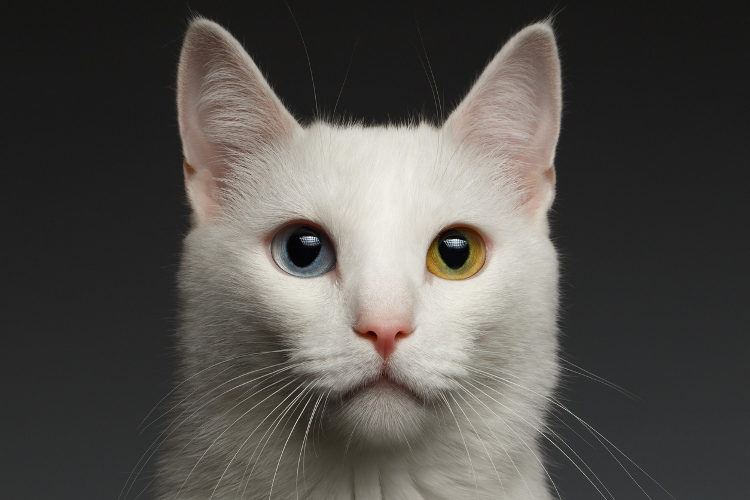A few nights ago my cat Jax was hanging out on my lap when suddenly he got up, stalked over to the wall, and began staring at a spot about six feet off the floor with an intensity reserved for Atlanta fans in the last twenty minutes of this year’s super bowl. I couldn’t see a damn thing on that wall, but clearly, he could. For twenty minutes, he just stared. Then he came back to my lap and went to sleep.
If you’re a cat owner, you’ve probably, experienced this and thought, “What the heck are you looking at, cat?” As you might imagine, there are some profound differences between a cat and human vision, and while we can’t be certain exactly how the feline brain processes the images it receives, we can make some assumptions based on our understanding of the feline eye.
Cats’ eyes are an evolutionary marvel. When I was a vet tech and we had to remove a cat’s eye (it had been hit by a car and lost the eye), seeing the intricacies of the cat eye was fascinating. Shaped by millennia of environmental factors and survival skills, cats have developed a way of seeing that is ideally suited to their lives as hunters. Here we’ll look at a few key aspects of feline vision, and the ways you can tailor your home décor to the way your cats see.
Peripheral Vision
Humans and cats each use rod and cone type photoreceptors in the eye to help them see. Rods are better suited to night and peripheral viewing, while cones help distinguish colors. In the feline eye, rod receptors our number cones, giving cats a distinct advantage over humans when viewing objects at the outer edges of their visual field. So, while humans have a panoramic field of about 180 degrees, cats possess a more panoramic 200-degree visual field range. This allows them to see potential prey at the edges of their vision and helps them detect approaching threats. Or see something so tiny on the wall you can’t see it.
Distance vs Close-up Viewing
Cats’ eyes are designed to emphasize their immediate environment, so they don’t have much use for distance viewing. This is one area where humans have an advantage. Cats can see detail in a 20-foot range, whereas humans can discriminate visual details at 100 to 200 feet. This allows the cat to focus on what is in its immediate area. To our cats, landscapes appear only in soft focus as areas of light and shadow.
Cat’s Night Vision
Ever walk into your house at night and jumped because you saw glowing eyes — and it turns out it’s just the cat? Well, cats are famous for their ability to see at night. Why? Because they are crepuscular hunters (seeking prey most often at dawn and dusk), they have eyes perfectly suited to the lighting conditions during these times of the day. Not only do their eyes possess more rods than cones, which helps them distinguish contrasts rather than colors, but they also have something called a tapetum—a part of the eye itself that gathers and refocuses “lost light” back on the retina (hence the glowing!). By making better use of available light, cats are better adapted to low-light viewing than humans.
Color
Cats are less sensitive to color than are humans, so it is likely that they see a “desaturated” world compared to the one human eyes perceive. Their color range is limited primarily to blues and greens so that colors such as reds, pinks, and oranges tend to skew toward the blue end of the visual spectrum.
Movement
Because cats are natural hunters, their vision is cued by motion. Sudden erratic movements (such as those of a mouse or bird) are more likely to draw a cat’s interest, while slow-moving objects are likely to be perceived by cats as stationary. This difference allows cats to hone in on potential prey, and to track and anticipate the movements of prey animals.
Cat-Friendly Décor
Understanding the way your cats perceive the world can also help you make more cat-friendly decorating choices in your home. So here are a few tips on making your living space more feline-friendly.
- Avoid clutter. Yes, cats can gracefully navigate a shelf of nick-knacks, but they are just as apt to see how many they can send crashing to the floor. So if you have objects you want to display, you may want them behind glass.
- Limit launch pads. Cats are natural born jumpers who will seek the highest point in a room. So unless you want your cat to have access to the top of your china cabinet or book shelves, don’t provide an easy launch pad. A missed jump can result in damage, both to your cat and your stuff.
- Easy on the fringe. There are a few things cats can’t resist. Ornamental fringe on furniture, bed skirts or table cloths may prove too great a temptation for even the most well-behaved kitty.
- Give your cats a play area. Designate some items or areas in your home as safe for feline play. Scratching posts, toys, and hiding boxes can all keep cats harmlessly delighted and amused, so provide a place where your cats can get their sillies out.






